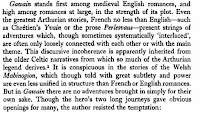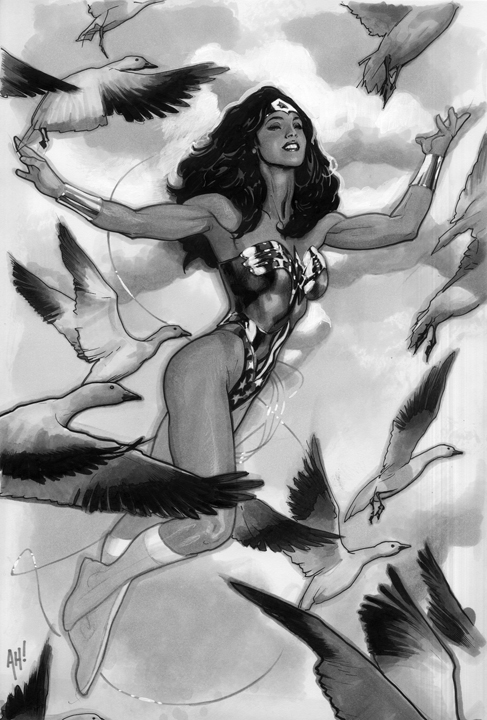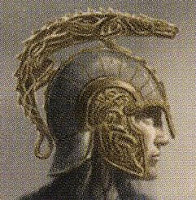Para quem achava que Tolkien criou o conceito das "torres sobre torres, montes sobre montes", "montanha de ferro e rocha adamantina" combinados fica aí essa passagem do Paraíso Perdido realçada por uma belíssima picture do Monte Olimpo com a mesma descrição onde não falta o ouro da descrição original.

Os anjos rebeldes do Paraíso Perdido de Milton que voavam com literal "velocidade alada" para se reunir na fortaleza de Lúcifer no Norte do céu no livro, descrita na mesma passagem do poema ( fim do livro V), parecem ser paralelos demais com certos detalhes dos Balrogs como servos de Morgoth em Angband e Utumno. Todas as fortalezas estão no Norte, a reunião deles lá foi antes de grandes batalhas com os poderes do "Bem", Guerra dos Valar e Guerra da Ira. Utumno ficava debaixo de Montanhas e Angband era uma montanha e uma vasta masmorra e catacumba construída debaixo delas.
A descrição da Montanha Fortaleza de Lúcifer que, muito provavelmente, serviu de base pra descrição que Tolkien deu da Torre Negra.
Comparem a similaridade do texto traduzido em prosa pro castelhano. Isso faz parte do relato de Gabriel para Adão no livro V do épico de Milton, contando a história da Guerra dos Anjos no Céu.
«Mientras hablaba así el Hijo, caminaba Satán en apresurado vuelo ( winged speed)con sus secuaces; ejército más innumerable que las estrellas de la noche o las matutinas gotas de rocío que, como relucientes perlas engasta el sol en las plantas y las flores. Atraviesan una y otra región, los poderosos reinos de los serafines de las potestades y de los tronos en sus triples grados; comparados tus dominios, Adán, con aquellas regiones, serían lo que tu jardín con respecto a toda la tierra a los mares todos al globo entero, desplegado en toda su longitud. De esta suerte llegan por fin a las extremas partes del norte, y Satán a su mansión regia, fabricada en lo más alto de un monte, que se divisaba a lo lejos como una montaña sobrepuesta a otra, con pirámides y torres hechas de agramilado diamante y de rocas de oro; que era el palacio del célebre Lucifer, según en su lenguaje llaman los hombres a esta clase de construcciones; pues para afectar mayor igualdad con Dios, imitando el nombre de la montaña en que acababa de proclamarse al Mesías rey de los cielos, él llamó a la suya montaña de la Alianza. Y convocando en torno de ella a todos sus secuaces con pretexto de que así se le ordenaba para consultarlos sobre el ostentoso recibimiento que habían de hacer a su Soberano luego que se presentase, y valiéndose del arte con que sabía fingir el acento de la verdad cautivó su atención diciéndoles:
Comparem com a descrição da Torre Negra nessa passagem do SdA aí. Depois coloco em inglês, é que a forma poética do Paraíso Perdido é meio estranha e a tradução brasileira em poema , honestamente,não ajuda a ver todas as similaridades.
Então, finalmente, seu olhar foi detido: muralhas e mais muralhas, parapeito sobre parapeito, negra, incomensuravelmente forte, montanha de ferro, portão de aço, torre de diamante, ele a viu: Barad-dûr, a Fortaleza de Sauron. Perdeu todas as esperanças.
(...)
E ali, na soleira escura das Sammath Naur, bem acima das planícies de Mordor, tal estupefação e terror sobrevieram que ele ficou parado, esquecido de todo o resto, imóvel como alguém que foi transformado em pedra. Teve uma visão rápida de nuvens rodopiando, e no meio delas torres e ameias, altas como colinas, fundadas sobre um poderoso trono de montanha acima de abismos incomensuráveis; grandes pátios e calabouços, prisões sem olhos,íngremes como penhascos, e portões escancarados feitos de ferro e pedra adamantina: e então tudo acabou. Torres caíram e montanhas deslizaram; paredes desmoronaram e derreteram, esboroando-se; enormes espirais de fumaça e jatos de vapor subiam, subiam e se espalhavam, até formarem um teto semelhante a uma onda ameaçadora, e sua crista alucinada se crispou e veio descendo e cobrindo tudo, espumando sobre a terra.
Se a Torre negra foi "copiada" dessa passagem é bem possível que o velocidade alada da travessia de Hithlum também o foi já que estão virtualmente no mesmo trecho do livro ( um dos melhores sem dúvida alguma)
Comparem:
So spake the Son, but SATAN with his Powers
Farr was advanc't on winged speed, an Host
Innumerable as the Starrs of Night,
Or Starrs of Morning, Dew-drops, which the Sun
Impearls on every leaf and every flouer.
Regions they pass'd, the mightie Regencies
Of Seraphim and Potentates and Thrones
In thir triple Degrees, Regions to which
All thy Dominion, ADAM, is no more
Then what this Garden is to all the Earth,
And all the Sea, from one entire globose
Stretcht into Longitude; which having pass'd
At length into the limits of the North
They came, and SATAN to his Royal seat
High on a Hill, far blazing, as a Mount
Rais'd on a Mount, with Pyramids and Towrs
From Diamond Quarries hew'n, & Rocks of Gold,
The Palace of great LUCIFER, (so call
That Structure in the Dialect of men
Interpreted) which not long after, hee
Affecting all equality with God,
In imitation of that Mount whereon
MESSIAH was declar'd in sight of Heav'n,
The Mountain of the Congregation call'd;
For thither he assembl'd all his Train,
Pretending so commanded to consult
About the great reception of thir King,
Thither to come, and with calumnious Art
Of counterfeted truth thus held thir ears.
Comparemos com a descrição da Torre Negra:
Fire glowed amid the smoke. Mount Doom was burning, and a great reek rising. Then at last his gaze was held: wall upon wall, battlement upon battlement, black, immeasurably strong, mountain of iron, gate of steel, tower of adamant, he saw it: Barad-dûr, Fortress of Sauron. All hope left him ( Fellowship of the Ring).
(...)
A brief vision he had of swirling cloud, and in the midst of it towers and battlements, tall as hills, founded upon a mighty mountain-throne above immeasurable pits; great courts and dungeons, eyeless prisons sheer as cliffs, and gaping gates of steel and adamant: and then all passed. Towers fell and mountains slid; walls crumbled and melted, crashing down; vast spires of smoke and spouting steams(-The Return of the King)

Novamente destaquemos algumas similaridades com Utumno e Angband: é uma montanha que fica no Norte do Céu assim como Utumno e Angband ficavam no Norte, Utumno ficava debaixo de Montanhas e Angband ficava debaixo e era , literalmente, uma Montanha. Nessa passagem os anjos rebeldes são genericamente chamados de "Poderes" e voam com velocidade alada e os Balrogs são Demônios de "Poder", Valaraukar.
Semelhanças com a Torre Negra, é uma montanha que era "como montes sobre montes, com "Pirâmides e Torres feitas com diamante escavado".
Olhem só "torres", "torre de diamante", "muro sobre muro", refletindo, as mesmas "torres de diamante esculpido", e o "monte sobre monte" e a sugestão de que a Torre Negra era uma montanha artificial esculpida à semelhança de um Trono, que contém não uma mas "várias" torres. Tudo isso encontrado nessa passagem de Milton que por assim dizer, foi feita para dar uma idéia do que é que a Torre de Babel bíblica tentava imitar.
Reparem como a imagética é igual sugerindo dureza, orgulho, altura, a fusão do ferro com o diamante, a coroa de ferro onde os silmarils se engastam, aliás, a torre negra tinha uma "coroa" o que a fazia ser uma espécie de categral "gothica" lembrando o próprio Morgoth, envergando a coroa de ferro onde o "diamante" e o "ferro"estavam profanamente combinados.
E, justamente, um pouco antes disso vem a passagem dos anjos voando com "winged speed".
Pode ser coincidência? Pode , mas nesse caso em particular, com bons motivos, eu duvido muito.
Vale lembrar que a imagem da Torre Adamantina também foi aproveitada por Phillip Pullman, fazendo dela a fortaleza de Lorde Azriel, o anti-herói da trilogia His Dark Materials, fazendo o serviço do Demo e morando numa cidadela montanhosa com torre de diamante enquanto fazia seus preparativos na guerra contra a Autoridade
The rest came to sit near Ruta Skadi to hear what she could tell them. She told what had happened when she flew up to meet the angels, and then of her journey to Lord Asriel's fortress.
"Sisters, it is the greatest castle you can imagine: ramparts of basalt, rearing to the skies, with wide roads coming from every direction, and on them cargoes of gunpowder, of food, of armor plate. How has he done this? I think he must have been preparing this for a long time, for eons. He was preparing this before we were born, sisters, even though he is so much younger.... But how can that be? I don't know. I can't understand. I think he commands time, he makes it run fast or slow according to his will.
"And coming to this fortress are warriors of every kind, from every world. Men and women, yes, and fighting spirits, too, and armed creatures such as I had never seen—lizards and apes, great birds with poison spurs, creatures too outlandish to have a name I could guess at. And other worlds have witches, sisters; did you know that? I spoke to witches from a world like ours, but profoundly different, for those witches live no longer than our short-lifes, and there are men among them, too, men-witches who fly as we do...."
(...) From The Amber Spyglass:At the western end of a range of saw-toothed mountains, on a peak that commanded wide views of the plain below and the valleys behind, a fortress of basalt seemed to grow out of the mountain as if some volcano had thrust it up a million years ago.
In vast caverns beneath the rearing walls, provisions of every sort were stored and labeled; in the arsenals and magazines, engines of war were being calibrated, armed, and tested; in the mills below the mountain, volcanic fires fed mighty forges where phosphor and titanium were being melted and combined in alloys never known or used before.
On the most exposed side of the fortress, at a point deep in the shadow of a buttress where the mighty walls rose sheer out of the ancient lava-flows, there was a small gate, a postern where a sentry watched day and night and challenged all who sought to enter.
While the watch was being changed on the ramparts above, I the sentry stamped once or twice and slapped his gloved hands on his upper arms for warmth, for it was the coldest hour of the night, and the little naphtha flare in the bracket beside him gave no heat. His relief would come in another ten minutes, and he was looking forward to the mug of chocolate, the smokeleaf, and most of all his bed.
To hear a hammering at the little door was the last thing he expected. However, he was alert, and he snapped open the spy hole, at the same time opening the tap that allowed a flow of naphtha past the pilot light in the buttress outside. In the glare it threw, he saw three hooded figures carrying between them a fourth, whose shape was indistinct, and who seemed ill, or wounded.
The figure in front threw hack his hood. He had a face the sentry knew, but he gave the password anyway and said, "We found him at the sulphur lake. Says his name is Baruch. He's got an urgent message for Lord Asriel."
The sentry unbarred the door, and his terrier daemon quivered as the three figures maneuvered their burden with difficulty through the narrow entrance. Then the daemon gave a soft involuntary howl, quickly cut off, as the sentry saw that the figure being carried was an angel, wounded: an angel of low rank and little power, but an angel, nevertheless.
"Lay him in the guardroom," the sentry told them, and as they did so, he turned the crank of the telephone bell and reported what was happening to the officer of the watch.
On the highest rampart of the fortress was a tower of adamant: just one flight of steps up to a set of rooms whose windows looked out north, south, east, and west. The largest room was furnished with a table and chairs and a map chest, another with a camp bed. A small bathroom completed the set.
Lord Asriel sat in the adamant tower facing his spy captain across a mass of scattered papers. A naphtha lamp hung over the table, and a brazier held burning coals against the bitter chill of the night. Inside the door, a small blue hawk was perching on a bracket.



































